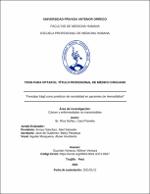Fenotipo frágil como predictor de mortalidad en pacientes de hemodiálisis

View/Open
Download
(application/pdf: 1.171Mb)
(application/pdf: 1.171Mb)
Date
2021Author(s)
Rios Nuñez, Carol Pamela
Metadata
Show full item recordAbstract
Objetivo: Evaluar si el fenotipo frágil es un predictor de mortalidad en pacientes
de hemodiálisis del Hospital Víctor Lazarte Echegaray durante el periodo 2019-
2020.
Material y métodos: Se realizó un estudio observacional, analítico, prospectivo,
de cohorte. La población de estudio estuvo constituida por 117 pacientes
ambulatorios del programa de hemodiálisis mayor o igual a 18 años atendidos
en el Hospital Víctor Lazarte Echegaray entre junio del 2019 y julio del 2020. El
fenotipo frágil se evaluó al inicio del estudio mediante los criterios de Fried. El
seguimiento de mortalidad se realizó durante un año
Resultados: Se encontró que el fenotipo frágil no es un factor predictor de
mortalidad (p= 0,121; RR: 1,615 IC:95% [0,874 - 2,984]). Del total de pacientes
frágiles el 33% falleció y del total de pacientes pre frágiles y no frágiles el 20.6%
falleció. Entre las variables intervinientes, se encontró que la edad es factor
asociado a mortalidad (p= 0.021; RR: 3,027 IC:95% [1.114 –13.104]), la
hipoalbuminemia también fue significativa (p= 0.024; RR: 7.109; IC:95% [ 1.118–
3.602]).
Conclusión: El fenotipo frágil no es un factor predictor de mortalidad en
pacientes de hemodiálisis. Objective: Assess whether Frail phenotype predicts mortality in hemodialysis
patients at Victor Lazarte Echegaray Hospital within 2019-2020.
Material and methods: An observational, analytical, prospective, cohort study
was carried out. The study population consisted of 117 outpatients of the
hemodialysis program equal to or greater than 18 years treated at the Víctor
Lazarte Echegaray Hospital between June 2019 and July 2020. Frail phenotype
was evaluated at the beginning of the study using Fried's criteria. Mortality followup was carried out for one year.
Results: It was found that Frail phenotype is not a predictor of mortality (p =
0.121; RR: 1.615 CI: 95% [0.874 - 2.984]). Of the total of frail patients, 33% died
and of the total of pre-frail and non-frail patients, 20.6% died. Among the
intervening variables, age was found to be a factor associated with mortality (p =
0.021; RR: 3.027 CI: 95% [1114 –13.104]), hypoalbuminemia was also significant
(p = 0.024; RR: 7.109; CI: 95% [1,118-3,602]).
Conclusion: Frail phenotype is not a mortality predictive factor in hemodialysis
patients.
Subject
Collections
- Medicina Humana [3196]

